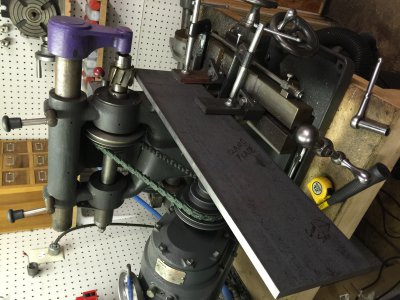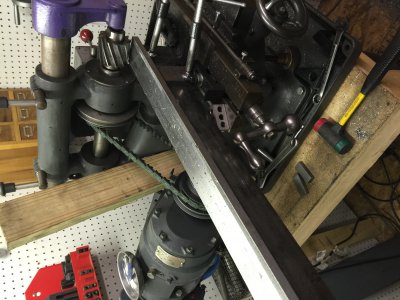I gathered a lot of hot rolled steel to start this project. I wanted cold roll but the only place I can get it is online and the steel came to over $350 but the shipping was horrible. This made using hot roll my only choice as my budget does not support that expense.
That being said I have spent the last few days sawing up 1/2" steel flat stock into the required pieces. I then milled all the edges to size and square. The base plate and bending leaf are rather large pieces and have been difficult.

In the above photo I milled the base clamping plate to get a good square edge as the hot rolled steel has a rounded edge. This was done to all edges of each piece but a few of the pieces are way too large for my small Burke mill so I have to get creative. Using C clamps and blocks I rigged a setup to mill the long edge but it has to be done in four steps because the travel on the 16" table is only about 7" or 8".

The bending leaf in the prints is a 1/2" thick plate 4" wide. I feel the 1/2" surface is not adequate to make good bends especially in heavier sheet metal without leaving a Mark, so I chose to make the bending surface 2" high instead of 1/2". To do this, I acquired a 26" long piece of 4" X 6" X 1/2" thick angle iron. The first step was to use a torch and cut the 6" side of the angle iron down to a little over 2" and mill the cut edge flat. To my amazement, the hot rolled angle iron is far from square or flat. This meant now I have to rig a setup to mill the face that does the bending flat and square. This is shown in the above photo. Cutting these two pieces has taken three days on the mill. It takes moving the part in the setup four times for each pass and each edge took at lest four passes. This was a lot of setups and very time consuming. BUT I GOT 'ER DONE

. Now, if I had been blessed with a 42" Bridgeport, this would have been a piece of cake, but I like to think I have illustrated almost anything is possible even if you only have a "little" machine. The next step will be to start shaping some of the pieces and drilling and tapping a lot of holes. I have spent about $50 and ordered a .625", a .750" , and a .375" reamer to make good finish and accurate holes. ( I couldn't afford to buy a whole set of reamers for around $200 , so I usually order them as I need them and have been building a set that way. It is more expensive in the long run but cheaper at time needed.)




 . Now, if I had been blessed with a 42" Bridgeport, this would have been a piece of cake, but I like to think I have illustrated almost anything is possible even if you only have a "little" machine. The next step will be to start shaping some of the pieces and drilling and tapping a lot of holes. I have spent about $50 and ordered a .625", a .750" , and a .375" reamer to make good finish and accurate holes. ( I couldn't afford to buy a whole set of reamers for around $200 , so I usually order them as I need them and have been building a set that way. It is more expensive in the long run but cheaper at time needed.)
. Now, if I had been blessed with a 42" Bridgeport, this would have been a piece of cake, but I like to think I have illustrated almost anything is possible even if you only have a "little" machine. The next step will be to start shaping some of the pieces and drilling and tapping a lot of holes. I have spent about $50 and ordered a .625", a .750" , and a .375" reamer to make good finish and accurate holes. ( I couldn't afford to buy a whole set of reamers for around $200 , so I usually order them as I need them and have been building a set that way. It is more expensive in the long run but cheaper at time needed.)